An annular “Ring of Fire” solar eclipse will occur on Sunday, February 26, 2017, beginning at 12:10 PM UTC (7:10 AM EST), peaking at 2.58 PM UTC (9:58 AM EST) and setting at 5.35 PM UTC (12:35 EST). The eclipse will occur in the Southern Hemisphere along a very narrow path (shown in the map below) beginning over the South Pacific Ocean, crossing South America and the Southern Atlantic Ocean and ending in Africa. According to Vedic astrology, an eclipse affects the whole world, but important geopolitical events are often stirred up more in the areas where the eclipse shadow actually falls.
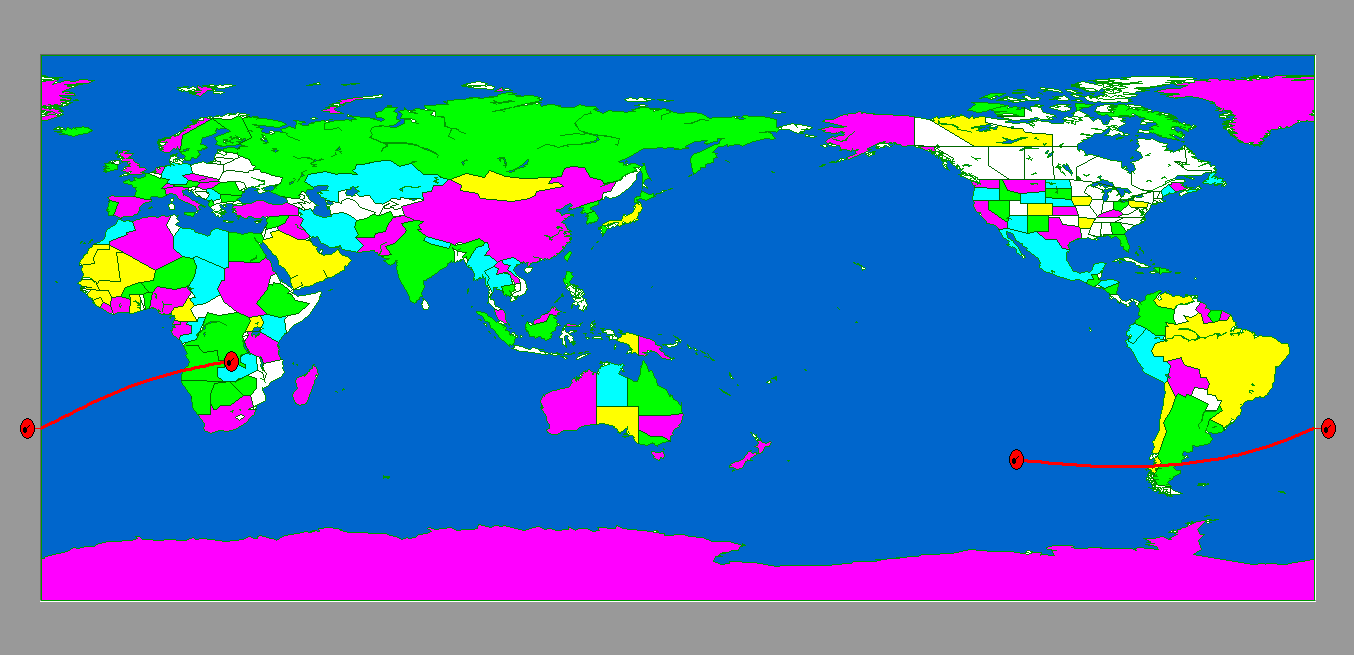 The “ecliptic” is the apparent path of the Sun, i.e., the Sun’s path as it’s seen from the Earth. The name is derived from ecliptik (Late Latin) ecliptica linea, literally, “line of eclipses.” Eclipses occur where the path of the Moon crosses the path of the Sun in the northern or southern direction. These crossing points where eclipses occur are known as the lunar nodes. The intersection point on the ascending path is called the North Node, Rahu, the Dragon’s Tail or Caput Draconis. The intersection point on the descending path is known as the South Node, Ketu, the Dragon’s Tail or Caudus Draconis.
The “ecliptic” is the apparent path of the Sun, i.e., the Sun’s path as it’s seen from the Earth. The name is derived from ecliptik (Late Latin) ecliptica linea, literally, “line of eclipses.” Eclipses occur where the path of the Moon crosses the path of the Sun in the northern or southern direction. These crossing points where eclipses occur are known as the lunar nodes. The intersection point on the ascending path is called the North Node, Rahu, the Dragon’s Tail or Caput Draconis. The intersection point on the descending path is known as the South Node, Ketu, the Dragon’s Tail or Caudus Draconis.
 The word “eclipse” is Late Middle English via Latin and the Greek “ekleiptikos” or “ekleipein” meaning “fail to appear.” A solar eclipse falls on a new Moon when the Sun, Moon, and Earth line up, and the Moon blocks the light of the Sun. In Hindi, the name for eclipse is “grahan,” so Vedic astrology calls a solar eclipse “Surya (Sun) grahan.” A lunar eclipse occurs on full Moon when the light of the Moon is blocked by the Earth’s shadow as the Earth is between the Sun and Moon. In Vedic astrology, the lunar eclipse is known as “Chandra (Moon) grahan.”
The word “eclipse” is Late Middle English via Latin and the Greek “ekleiptikos” or “ekleipein” meaning “fail to appear.” A solar eclipse falls on a new Moon when the Sun, Moon, and Earth line up, and the Moon blocks the light of the Sun. In Hindi, the name for eclipse is “grahan,” so Vedic astrology calls a solar eclipse “Surya (Sun) grahan.” A lunar eclipse occurs on full Moon when the light of the Moon is blocked by the Earth’s shadow as the Earth is between the Sun and Moon. In Vedic astrology, the lunar eclipse is known as “Chandra (Moon) grahan.”
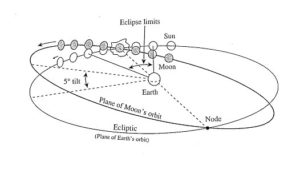 The eclipses do have to happen exactly on the new and full Moon, but because of the Moon’s tilt to the ecliptic and the Earth, an eclipse cannot happen every full or new Moon. Further, the luminaries (Sun and Moon) are not always exactly conjunct (in the same celestial longitude) as the lunar nodes. Solar and lunar eclipses occur ~every six months and follow each other within a two-week time span. Sometimes the lunar eclipse occurs before the solar, and sometimes it is the other way, and sometimes there are three eclipses in a row, but usually just two. Vedic astrology teaches that the world will have more unrest when the lunar eclipses precede the solar eclipses, as we see happening in 2017.
The eclipses do have to happen exactly on the new and full Moon, but because of the Moon’s tilt to the ecliptic and the Earth, an eclipse cannot happen every full or new Moon. Further, the luminaries (Sun and Moon) are not always exactly conjunct (in the same celestial longitude) as the lunar nodes. Solar and lunar eclipses occur ~every six months and follow each other within a two-week time span. Sometimes the lunar eclipse occurs before the solar, and sometimes it is the other way, and sometimes there are three eclipses in a row, but usually just two. Vedic astrology teaches that the world will have more unrest when the lunar eclipses precede the solar eclipses, as we see happening in 2017.
Astronomers and astrologers recognize various kinds of eclipses which are calculated according to the celestial latitude and longitude of the luminaries and the lunar nodes at the full or new Moon. These variations are total, partial, annular, or hybrid for solar eclipses; and total, partial, and appulse (penumbral) for lunar eclipses. A total solar eclipse occurs when the Moon completely covers the Sun; a partial solar eclipse happens when the Moon only partially covers the disk of the Sun.
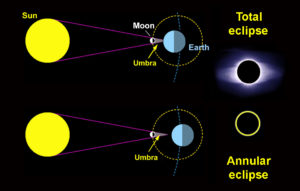 An annular eclipse happens when the new Moon is too far away and too small to totally cover the solar disk; which occurs when the Moon is on the far side of its orbit so its umbral shadow is not long enough to reach Earth. A hybrid eclipse involves both an annular and a total eclipse. The February 26 eclipse is an annular one. Those on its path will see the annulus of bright sunlight around the dark Moon which is why it is called the “Ring of Fire” eclipse. (Image below is of annular eclipse via Wikipedia).
An annular eclipse happens when the new Moon is too far away and too small to totally cover the solar disk; which occurs when the Moon is on the far side of its orbit so its umbral shadow is not long enough to reach Earth. A hybrid eclipse involves both an annular and a total eclipse. The February 26 eclipse is an annular one. Those on its path will see the annulus of bright sunlight around the dark Moon which is why it is called the “Ring of Fire” eclipse. (Image below is of annular eclipse via Wikipedia).
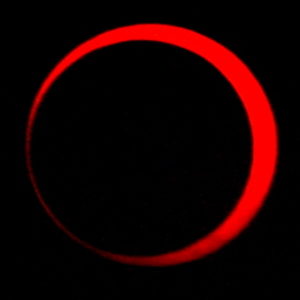 To understand eclipses it helps to know that, though the lunar nodes are not planets, they have the same power as planets in astrology, and are called shadow planets or chaya graha. In natal and transit charts as well as progressed cycles, Rahu and Ketu represent the karmic axis and show us much about our evolutionary journey and what in our karma needs to be stirred up to help us move forward. They traverse one rashi (sign) every 18 months and take about 18 years to traverse the whole zodiac. Eclipses occur in the signs where the lunar nodes are transiting.
To understand eclipses it helps to know that, though the lunar nodes are not planets, they have the same power as planets in astrology, and are called shadow planets or chaya graha. In natal and transit charts as well as progressed cycles, Rahu and Ketu represent the karmic axis and show us much about our evolutionary journey and what in our karma needs to be stirred up to help us move forward. They traverse one rashi (sign) every 18 months and take about 18 years to traverse the whole zodiac. Eclipses occur in the signs where the lunar nodes are transiting.
One way that some astrologers look at the difference between the luminaries and the nodes in an eclipse is that the luminaries determine the timing of the eclipse (when they are exactly conjunct or opposite), whereas the lunar node marks the zodiac point of the eclipse which will be most activated. I have found that both points, the luminaries and the node, can be trigger points. In the February 26, 2017 eclipse, the mean lunar node Ketu at 9 degrees Aquarius will eclipse the Sun and Moon at 14 degrees Aquarius, all in Shatabisha nakshatra. The zodiac position of the node at maximum eclipse (near the exact full or new Moon) sometimes becomes a “critical degree” afterward. Astrologers will watch transits to these eclipse points in the future.
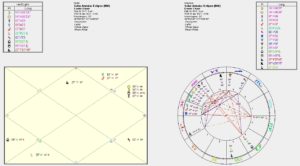 Rahu and Ketu block the light of the Sun and Moon in eclipses, and this often signals dynamic changes especially when the eclipse occurs within ~three degrees of a conjunction or aspect to a natal planet or angle cusp. How we express the energy of that planet or chart point will undergo a rebooting and rebirthing process both before and after the eclipse. Astrologers have access to complex techniques to determine how long going backward and forward an eclipse will resonate.
Rahu and Ketu block the light of the Sun and Moon in eclipses, and this often signals dynamic changes especially when the eclipse occurs within ~three degrees of a conjunction or aspect to a natal planet or angle cusp. How we express the energy of that planet or chart point will undergo a rebooting and rebirthing process both before and after the eclipse. Astrologers have access to complex techniques to determine how long going backward and forward an eclipse will resonate.
Whether the changes suggested by an eclipse are “easy or difficult” depends on the natal significations of the eclipsed planet or point, as well as aspects, yogas, and cycles, as well as the eclipse axis itself. Both solar and lunar eclipses have an influence on all areas of life including personal relationships, health, professional matters, finances, and inner growth, and these areas will be highlighted according to the planets, signs, and houses where the eclipses fall within a natal or mundane horoscope.
A solar eclipse carries more weight than a lunar eclipse. Further, an eclipse will be strongest to bring change when many planets line up in the eclipse axis; and, when the luminaries are closest to the node (as in total eclipses). Thus, the February 26 annular eclipse will not be as strong as the total eclipse in August 2017 will be. Yet, the February eclipse involves several planets: Mercury, Ketu, Sun, Moon, and Neptune. Mercury adds some auspicious energy to the mix for sure, but when it transits over the eclipse points from ~ February 28 to March 3, some noteworthy event(s) may be triggered related to communication; transportation; travel; business and commerce; news media and publishing; treaties, ambassadors, and matters of state; and armed services.
In regard to a personally significant eclipse, a Rahu eclipse (like the one next August) is often thought to be more of a positive force than a Ketu eclipse (like this one in February), especially in terms of material conditions. However, I have seen several cases in which a Ketu eclipse occurred in the days and weeks before someone received a major windfall. This can be explained by the fact that Ketu often represents past life merit and the release of karmic debts. Nonetheless, a Ketu eclipse initially feels more difficult and exhausting as it requires letting go of something or working something out in preparation for a new cycle ahead. For someone whose chart is directly affected as mentioned above, it can be very difficult for the emotional, mental, or physical health, and it can temporarily diminish confidence and clarity.
The rashi and nakshatra of the eclipse have a lot to say about possible areas of life which are more generally as well as specifically affected by eclipse. The February 26 eclipse occurs in Shatabisha nakshatra, which deals with healing, astronomy and astrology; stock exchange; fisheries and fishing; rivers, oceans, lakes, dams, reservoirs, and water supplies; prison reform; and electricity. The eclipse also falls in the middle of Aquarius, sign of the Water Bearer, which is also the sign of revolutions and rebellions; science, media, technology and invention; outer space; oil and oil wells; auto and airline industries; labor organizations; civil rights; reclaimed lands; and spirituality. The latter is also emphasized by the presence of Ketu and Neptune in the eclipse axis, which are also strong spiritual indicators.
 In the Washington DC eclipse chart, the rising sign is at 27 degrees sidereal Aries in the sharp, aggressive, altruistic, creative, and transformational (fiery) Krittika nakshatra. Mars, ruler of the Aries chart, conjoins Uranus in the twelfth house in Pisces. This gives some challenging results especially as it is afflicted by Uranus. Mars in the twelfth house can point to civil unrest that could require emergency measures; enemy espionage; underground movements to subvert the government; legal issues for the President and his administration (fines, insubordinate government employees, penalties, judicial conflicts, or threats of impeachment); increased crime; infectious diseases (public health crisis); and drastic changes to all kinds of policies and laws. The exalted Venus also conjunct Mars should help to calm and cool down Mars and Uranus, offering some diplomacy to the mix.
In the Washington DC eclipse chart, the rising sign is at 27 degrees sidereal Aries in the sharp, aggressive, altruistic, creative, and transformational (fiery) Krittika nakshatra. Mars, ruler of the Aries chart, conjoins Uranus in the twelfth house in Pisces. This gives some challenging results especially as it is afflicted by Uranus. Mars in the twelfth house can point to civil unrest that could require emergency measures; enemy espionage; underground movements to subvert the government; legal issues for the President and his administration (fines, insubordinate government employees, penalties, judicial conflicts, or threats of impeachment); increased crime; infectious diseases (public health crisis); and drastic changes to all kinds of policies and laws. The exalted Venus also conjunct Mars should help to calm and cool down Mars and Uranus, offering some diplomacy to the mix.
The eclipse falls in the eleventh house which is the best house for an eclipse to fall in, where malefics like Ketu tend to give overall good results. The eleventh house also has special reference to legislators and legislation (Congress); national goals; alliances with foreign countries; national treasury and stock exchange; foreign ambassadors; the Vice President of the country; state and city governing bodies; and gains from trade. Mercury in the eclipse axis promises an active and busy time in Congress this next year, with much new legislation affecting trade, commerce, and education.
However, with Ketu and Neptune involved, we will also see more of the same trend of political drama and deception; personal recriminations; and embittered arguments and disputes among various factions of government. Hopefully Ketu in the eclipse axis and eleventh house reflects some positive changes ahead for the government. Yet, the government is a reflection of the collective consciousness of the nation, which is not in good psychological shape now as Ketu is eclipsing the Moon, which represents the mass mind.
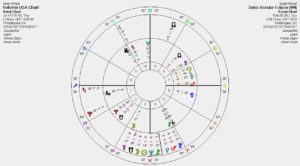 The US Moon eclipsed by Ketu has been moving into place since last summer and points to a great deal of anger, misery, delusion, fear, projection, divisiveness, and civil unrest. The Moon will be eclipsed in the third house of the US Kelleher chart, which is also indicative of major domestic changes ahead; continuing issues related to immigration policies; ongoing mistrust of the mainstream media; and general unrest and confusion among the people.
The US Moon eclipsed by Ketu has been moving into place since last summer and points to a great deal of anger, misery, delusion, fear, projection, divisiveness, and civil unrest. The Moon will be eclipsed in the third house of the US Kelleher chart, which is also indicative of major domestic changes ahead; continuing issues related to immigration policies; ongoing mistrust of the mainstream media; and general unrest and confusion among the people.
Nonetheless, for those who follow a more enlightened path of self-realization, the Ketu Aquarius eclipse can be one of awakening. I am also hopeful that as Ketu moves back past the Moon in April, and this might start to ease up some of our current state of public unrest, and I sense that around the August 2017 eclipses, when the lunar nodes change signs, we will begin to face a different set of issues related to the economy, food and water supplies, public health, and ongoing threats to First Amendment rights.
Raphael’s Mundane Astrology says that eclipses falling in Air signs like Aquarius signify “famine, sickness, pestilence, tempests and stormy winds hurtful to mankind.” In the second decan of Aquarius, the eclipse is said to “universally damage the seeds of the earth.” Yet, this eclipse is actually considered to be auspicious according to its Saros cycle, so I am not sure these admonitions apply.
Saros cycles are eclipse families designated by their “Saros Number.” This idea came from the ancient Babylonian astrologers who observed that eclipses occur in groups or families that link together the eclipses that happen every 18 years. These families evolve over cycles that last many centuries (10-15), comprising 80 eclipses in a series. Tracking these cycles is a very specific area of astrological research.
 The February 26, 2017 eclipse is a member of Saros 140 which was born April 16, 1512. The last one in this cycle was February 16, 1999 and before that, February 4, 1981. Astrologer Bernadette Brady, in Predictive Astrology: The Eagle and the Lark, describes this eclipse as “SS 19 South: This family of eclipses brings with it the elements of the pleasant surprise…sudden happiness, a joyful event, the lucky break, the lucky win. Events [around this eclipse] can positively change the person’s life.”
The February 26, 2017 eclipse is a member of Saros 140 which was born April 16, 1512. The last one in this cycle was February 16, 1999 and before that, February 4, 1981. Astrologer Bernadette Brady, in Predictive Astrology: The Eagle and the Lark, describes this eclipse as “SS 19 South: This family of eclipses brings with it the elements of the pleasant surprise…sudden happiness, a joyful event, the lucky break, the lucky win. Events [around this eclipse] can positively change the person’s life.”
With our thoughts, we make the world, and I for one will remain optimistic that events around the February 26, 2017 solar eclipse in the sign of the Water Bearer will bring healing, peace, and awakening to the world. For everyone and especially those whose natal horoscopes are closely influenced by this eclipse, I wish you a brilliant lucky break ahead!

